ElectricBus
Latest
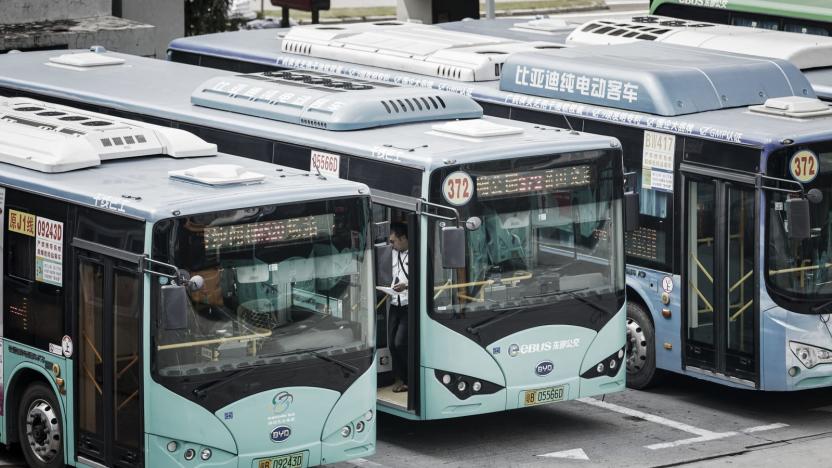
China's Shenzhen city electrifies all 16,359 of its public buses
If you ever see anyone crowing about how nobody's taking the initiative on sustainable transport, point them in the direction of Shenzhen. The Chinese city has announced that it has successfully electrified its entire fleet of public buses, all 16,359 of them. In addition, more than half of Shenzhen's cabs now run on electricity, and the plan is to get rid of the remaining gas-powered rides by 2020.
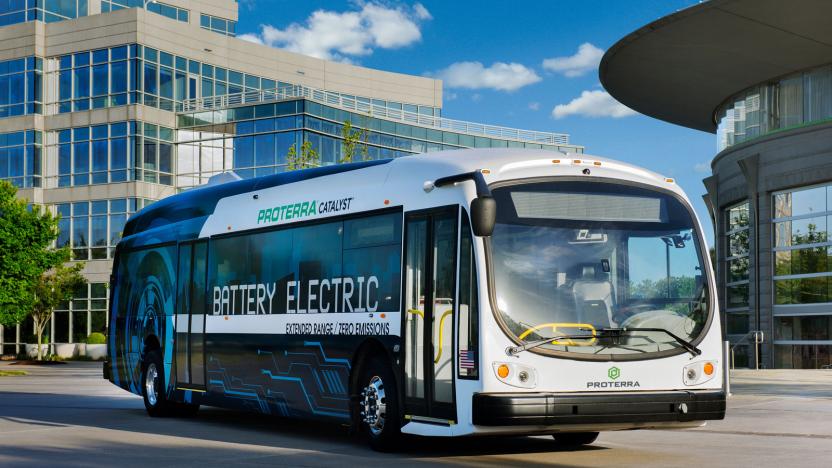
LA orders 25 of Proterra's electric buses
Los Angeles wants to field a completely electric fleet of buses by 2030, and it just took a large step toward making that a reality. The city's Department of Transportation (which runs the largest municipal transit in the county) has acquired 25 of Proterra's smaller 35-foot Catalyst buses, all of which should arrive in 2019. That may not sound like much, but it's a significant chunk of the DOT's 359-bus fleet. The deal promises real savings, too -- it should eliminate 7.8 million lbs. of greenhouse gas emissions per year and save $11.2 million in energy and maintenance over 12 years.
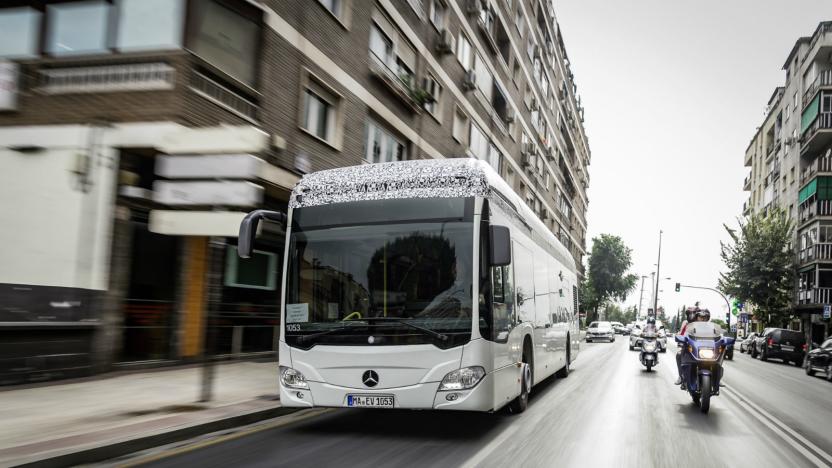
Mercedes' ubiquitous city bus is going electric in 2018
Mercedes-Benz wants an electric version of its long-running city bus to power the emissions-free mass transit future. Over a dozen cities recently pledged to make their bus fleets all-electric by 2030 (among them LA and Seattle). And, if the German auto-maker gets its way, its EV will be the one ferrying people around all hours of the day. Mercedes announced that it plans to start producing the electric "Citaro" by the end of 2018.
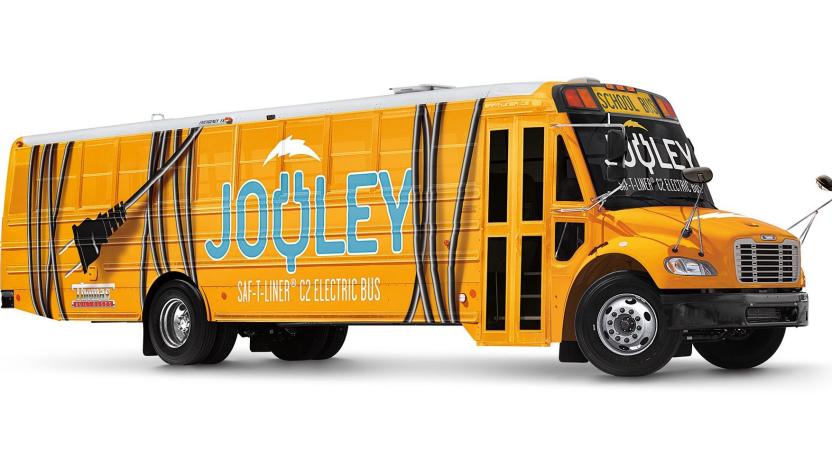
Daimler's electric school bus will have a 100-mile range
Most school buses don't scream "high-tech," but they're actually perfect candidates for electrification -- most run two short routes and have long breaks for recharging. Daimler and its Thomas Built Buses division have unveiled an electric bus called the Jouley that should be able to handle that task perfectly. It's got a 160 km (100 mile) all-electric range and can pack up to 81 kids "safely, quietly and emission-free," Thomas said. Should operators need more range, they can add another battery pack.

Electric bus sets record with 1,101-mile trip on a single charge
Think it was impressive when a Tesla club drove a Model S nearly 670 miles? It has nothing on what Proterra just managed. The startup just drove a Catalyst E2 Max electric bus a whopping 1,101.2 miles on a single charge. That's the furthest any EV has managed before recharging, and well past the 1,013.8 miles driven by the previous record-holder, a one-seat experimental car nicknamed "Boozer." It's not hard to see how Proterra managed the feat when you know about the technology, but this still bodes well for eco-friendly public transportation.
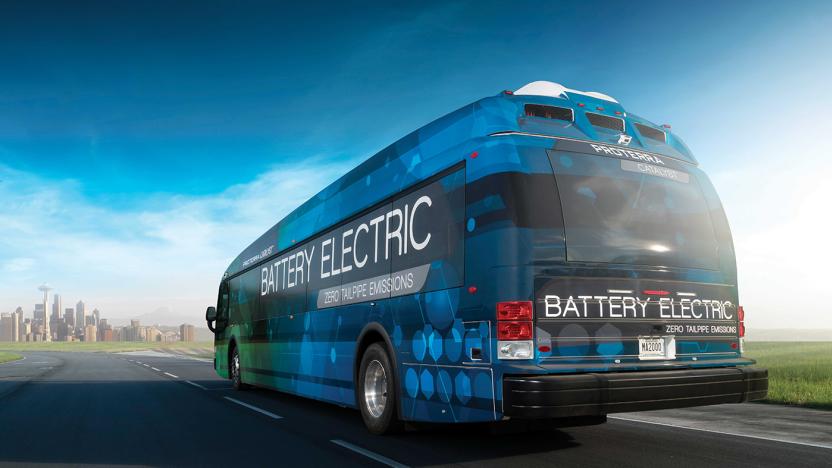
Proterra wants to build autonomous vehicles for public transit
The company that built an electric bus capable of driving 350 miles before needing a recharge wants to take public transit to the next level: autonomous driving. Working with the University of Nevada, Proterra has launched an autonomous driving program to help develop self-driving electric buses in Reno. The idea is simple, but implementation is complicated, partially because Proterra buses have to serve the public and abide by completely different laws than private vehicles. That's why the company's CEO says autonomous bus lines will probably never run without a human co-pilot.
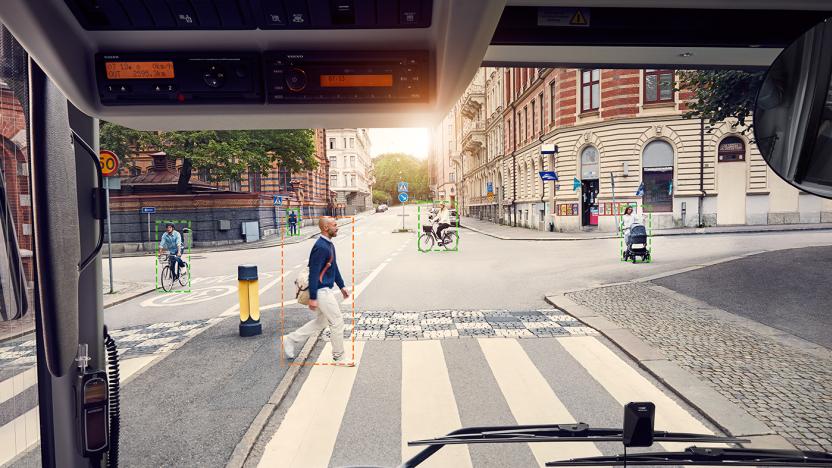
Volvo's e-buses will honk at oblivious pedestrians
Volvo's e-buses, which are already shuttling passengers in some European cities, are silent operators like other electric vehicles out there. The automaker's idea of minimizing their chances of colliding with pedestrians, however, is giving them the capability to make a lot of noise. Volvo's new pedestrian and cyclist detection system uses a camera to constantly monitor its buses' surroundings. If it spots someone nearby, it emits a gentle warning sound to signify that a vehicle is approaching. It also uses audio and visual cues to alert the driver of people nearby, just in case he's fallen asleep at the wheel. If it senses an "imminent risk of an accident," though, it does more than just give off a few beeps: it honks. Loudly.

Proterra's electric bus can travel 350 miles before recharging
A startup called Proterra has been working on electric buses for years, and its latest model has a pretty impressive range. Its Catalyst E2 Series buses can drive up to 350 miles on a single charge, which means it can go a quite a bit further than Tesla's top-tier Model S that already boasts a 300-plus-mile range. The vehicle can also outlast its predecessor that can only go for 258 miles. As Wired notes, electric buses might even be better than cars, since they don't need a huge network of charging stations. They drive a set route, so cities can simply install some where they're bound to pass -- the E2 might not even need to recharge until the end of the day. Further, not everyone can afford an electric vehicle, but most people can afford to ride a bus.

Inhabitat's Week in Green: of space elevators, floating cities and solar sheltered drinking machines
Each week our friends at Inhabitat recap the week's most interesting green developments and clean tech news for us -- it's the Week in Green. This week Inhabitat showcased several incredible examples of futuristic architecture, starting with an epic floating ark that houses a self-sustaining city at sea. We also saw a plan to harness carbon nanotubes to create the world's first space elevator, and we brought you an ingenious solar-powered shelter that harvests and purifies rainwater for drinking. In other news, Asia revved up the world of eco transportation as South Korea unveiled the world's first commercial electric bus, and Beijing launched a plan to cut eliminate gridlock by cutting vehicle registration by 2/3. We also checked in on the electric Bluebird supercar, which is gearing up to break the UK land speed record next year, and we took an in-depth look at the year's best electric vehicles. Finally, welcome to 2011! As the final countdown rang out we took a look at Times Square's dazzling 2011 eco ball, which is studded with 32,256 LEDs. We also looked back on Inhabitat's top green energy, transportation, and tech stories of 2010, and we rounded up the year's best green products and wearable technology concepts that stand to change the way we get dressed for the day. And if you're running errands this week to return any unwanted holiday gifts, check out Amazon's new preemptive return tool - it could save you a trip next year.

South Korea rolls out first commercial electric bus service, we are green with envy
The Seoul Metropolitan Government has just rolled out a world first by instating commercial, all electric bus service in the city. We've previously seen pilot programs and trials, but actual working commercial service has never been previously implemented. The program, developed in agreement with Hyundai Heavy Industries and Hankuk Fiber, and the buses themselves can run up to about 52 miles on a single charge (which takes about 30 minutes), and have a maximum speed of about 62 miles per hour. Though several other cities have small fleets of electric public transportation, Seoul has announced that half of its massive fleet of buses will be electric by 2020.

Inhabitat's Week in Green: solar robots that fly, CO2 fabric dye, and the dark silicon that boosts battery life
Each week our friends at Inhabitat recap the week's most interesting green developments and clean tech news for us -- it's the Week in Green. Solar power blazed a trail this week as we took a look at several hot new technologies, starting with SkyFuel's SkyTrough, which is being billed as the world's most efficient solar collector. We also saw solar energy take to the skies as designers unveiled plans for a fleet of high-flying solar robots, and we were surprised to learn that common household dyes could significantly increase the efficiency of photovoltaic panels by optimizing their color absorption spectrum. Speaking of dye, from the realm of wearable tech we also brought you a breakthrough new technique for dying fabric that saves water by utilizing fluid CO2. We also saw a prototype for a wired "safe cuddling" suit for kids that wards off improper touching by sounding an alarm, and if you're a fan of high-tech footwear, check out these tricked-out kicks that do double duty as Wii controllers. This week also saw a tremendous green boost for bits and bytes as the University of Leicester switched on its hyper-efficient ALICE supercomputer, which is ten times more powerful than its predecessor and stands to reduce yearly CO2 emissions by 800 tons. Meanwhile, researchers at UC San Diego revealed work on a new mobile phone chip that harnesses "dark silicon" to boost smartphone battery life by a factor of eleven. We also showcased several efficient autos as Southern California rolled out a fleet of all electric buses that can recharge in 10 minutes flat, and the hyper-miling Avion car embarked on a trip from Canada to Mexico with just 14 gallons of gas. And if you'll be doing some traveling of your own back to school this fall, you wont want to miss this chance to pick up an awesome solar-powered Sakku satchel. Finally, with Labor Day on its way why not upgrade your BBQ with an adorable altoids tin mini grill - it's curiously awesome!

Korea starts testing 'recharging road,' might make it part of its public transport system
Time to set aside the chains of worry that have prevented us from jumping on the electric bandwagon -- Korean researchers have figured out a way to make us forget all about charging stations and cruising ranges with their magnetically recharging road. The Online Electric Vehicle (OLEV) you see here went into service yesterday and can now be found towing three bus-loads of tourists around a Seoul amusement park. It operates on a battery five times smaller than conventional EV juice packs and can collect its power through non-contact magnetic transmission from the recharging strips in the ground. We're also told running costs for this system are a third of what a typical EV would require, and should it prove successful and find itself expanded to the public transport system, only about 20 percent of bus routes would need to be electrified -- at bus stops, crossroads and the like -- with the rest being covered by the power stored inside the OLEV. Here's to hoping it all works out.

E-Traction's in-wheel motor sportin' hybrid electric bus
We've seen in-wheel motors in the past, but implementing the technology is not without its share of challenges. On one hand, it's difficult to coordinate motors that have no mechanical connection to each other, while on the other hand electric motors are designed to spin much faster than the wheels, in order to generate the desired power -- adding complexity while decreasing efficiency. A company in the Netherlands called e-Traction may have those problems licked, and now they've developed a diesel-electric hybrid bus that they say offers fifty percent better fuel economy over existing diesel buses. The vehicle also employs a GPS-based system that switches off the diesel engine entirely while operating in areas with dense traffic, reducing emissions. The company has been awarded contracts to retrofit seven commercial buses with the technology, and hopes to branch out soon into garbage trucks -- because nothing says 'green' like hauling junk off to a landfill.





